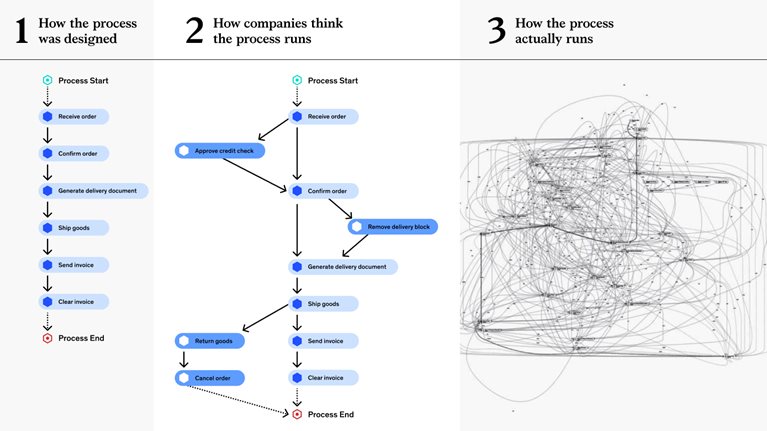Process excellence has never been more important as businesses adapt to macroeconomic challenges—recasting supply chains, decarbonizing functions, and scaling new capabilities. The first step to any transformation is documenting how your processes function and interact today.
But many leaders don’t have visibility into how complex their businesses are. How do you visualize a process that spans tens of thousands of locations? Has accumulated apps through years of mergers and acquisitions? And produces multiple versions of the same data?
For the last two years, McKinsey has collaborated with Celonis, the pioneer and global leader in process mining, to help clients do exactly this: visualize what is “under the hood” of their organizations. This week, McKinsey is pleased to formalize our partnership.
.png?cq=50&mh=145&car=16:9&cpy=Center)
“Celonis is one of our key strategic partners globally. When you have that Celonis visual in front of you, it's a very powerful thing. Companies can begin to understand the complexity of their business—the issues they work around every day—and address those inefficiencies toward greater productivity,” says Jan Wüllenweber, a McKinsey senior partner. “It enhances the speed and accuracy of any transformation.”
“Together, McKinsey and Celonis give organizations the unique business and technical expertise they need to outrun today’s global macroeconomic challenges,” says Bastian Nominacher, co-founder and co-CEO of Celonis. “I’m always impressed by the value customers are able to unlock with McKinsey guiding their business transformation based on process insights.”
“Our platform delivers end-to-end visibility into business processes—a data-driven, system-agnostic digital twin enriched with process intelligence,” explains Fabian Baldauf, senior director at Celonis. “This is coupled with McKinsey’s deep industry and organizational knowledge, and proven expertise in running transformation programs for its clients.”
Headquartered in Munich and New York City, Celonis was established in 2011 when its three co-founders, who met during a consulting project at university, decided to commercialize process mining and to start a company. Today, it has more than 3,000 employees, a $13 billion valuation, and leads one of the fastest-growing segments of the global IT market.
When you have that Celonis visual in front of you, it's a very powerful thing. Companies can begin to understand the complexity of their business—the issues they work around every day—and address those inefficiencies toward greater productivity.
Celonis technology can visualize a company’s end-to end-processes, no matter how sprawling or complex, and highlight bottlenecks and inaccurate data.
The cloud-based tool connects to an organization’s IT systems such as ERP, SCM and CRM systems. It captures the data from every split second of a process and extracts a digital footprint, creating a complete representation (a digital twin), similar to a subway map, of how the processes actually run. It is fact-based rather than anecdotal and can be created in days rather than weeks.

Operations
As little as three years ago, a team of experts would spend the first month of a project interviewing stakeholders, crunching data sets into spreadsheets, and recreating process flows on rolls of brown paper with markers and Post-its.
“Some projects actually took up entire hallways,” recalls Julian Fischer, a McKinsey partner. “But when you have something as complex as an order-to-cash function with millions of transactions, you can only capture a sliver of the depth of such a process. You hope to find the most important variations...but you can’t be fully exhaustive—or objective. Companies normally are blown away when we present the Celonis visuals, what we often call a 'treasure map' of insights.”
Samarth Shah, a McKinsey asset leader, explains a recent procure-to-pay project. In the first step, the McKinsey procurement experts identified the high-value use cases: where in the process can we make the greatest improvement?

In step two, the Celonis analysts finetuned and connected the tool to the client’s platform. “It can do a deep dive to visualize root causes and typically solves for a specific problem,” he says. Then our experts interpret the data, define what best-in-class is, and develop a plan for change. “Many fixes can be automated in the workflows; others through updating organizational processes and building capabilities,” he points out. “Once in place, the power comes from applying the tool across multiple functions.”
“The technology is increasingly being used to analyze and decarbonize functions, and to support gen AI projects by providing the process-related data, knowledge and intelligence needed to run large language models (LLMs),” explains Karel Dörner, senior partner at McKinsey.
Recently, a team helped a North American automotive original equipment manufacturer squeeze even greater efficiency out of one of their highest-performing sites. They wanted to reduce production cost per car; they already had mature lean manufacturing processes that produced high-quality, high-volume data.
The team mapped virtual process streams for 100,000 cars, discovering that repairs were a source of inefficiency. They identified actions that could result in a 20 percent performance improvement. The diagnostic also revealed that cars had been looping back and forth among different repair bays—which the company hadn’t realized—adding days to production. The project was completed in six weeks.